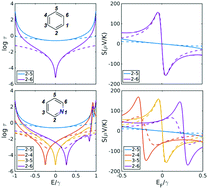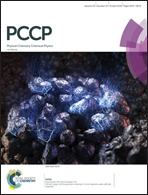Connectivity-driven bi-thermoelectricity in heteroatom-substituted molecular junctions†
Abstract
To improve the thermoelectric performance of molecular junctions formed by polyaromatic hydrocarbon (PAH) cores, we present a new strategy for enhancing their Seebeck coefficient by utilizing connectivities with destructive quantum interference combined with heteroatom substitution. Starting from the parent PAH, with a vanishing mid-gap Seebeck coefficient, we demonstrate that the corresponding daughter molecule obtained after heteroatom substitution possesses a non-zero, mid-gap Seebeck coefficient. For the first time, we demonstrate a “bi-thermoelectric” property, where for a given heteroatom and parent PAH, the sign of the mid-gap Seebeck coefficient depends on connectivity and therefore the daughter can exhibit both positive and negative Seebeck coefficients. This bi-thermoelectric property is important for the design of tandem thermoelectric devices, where materials with both positive and negative Seebeck coefficients are utilized to boost the thermovoltage. Simple parameter-free rules for predicting the Seebeck coefficient of such molecules are presented, which form a powerful tool for designing efficient molecular thermoelectric devices.



 Please wait while we load your content...
Please wait while we load your content...